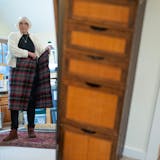Nancy Carlson has volunteered in every presidential election since John F. Kennedy defeated Richard Nixon in 1960. Now 81 and weakened by a blood disorder, Carlson is determined to do everything in her power to help get out the vote this fall.
Most afternoons, the former secretary roams the hallways and courtyards of Walker Methodist Plaza, a senior community in Anoka where she lives, seeking to engage fellow residents in conversations about voting. Gently and without mentioning any candidate by name, Carlson explains the absentee ballot process for those who may be unable to vote in person. Carlson estimates she has talked to at least 100 residents — some multiple times — in the past few months.
"This [election] may be my last go-round," said Carlson, who has angioectasia, an unusual dilation of blood vessels that can lead to fatigue. "I am on a mission."
That mission has never been more important — or more fraught.
This fall, Minnesota seniors who live in residential care communities face unprecedented challenges voting in an election upended by the coronavirus pandemic. Many are afraid to cast their ballots in person, worried about a virus that is resurging nationwide and has killed 2,301 Minnesotans — about 7 in 10 of whom lived in eldercare settings — and has infected nearly 130,000 statewide.
Family members and volunteers who would normally visit with seniors and do voter education are barred from entering many senior homes. And to protect older voters from the virus, dozens of polling locations across the state have been moved out of nursing homes and other senior care facilities — further limiting access to the ballot box.
The changes have senior advocacy groups and election experts worried that many of the 85,000 older Minnesotans who live in senior living communities will be unable to vote. The federal Centers for Medicare and Medicaid Services, which oversees nursing homes, recently notified state regulators they must "ensure a resident's right to vote is not impeded" during the pandemic. But about 70% of the state's 364 nursing homes have active outbreaks of COVID-19; and many do not have extra staff to help seniors with the logistics of voting, say nonprofit outreach groups.
To help fill this void, many senior residents are taking matters in their own hands. They are knocking on doors of fellow residents, handing out fliers and circulating absentee ballot applications. They are being supported by voter rights groups that have been contacting senior care facilities across the state, urging them to help older residents with the logistics of voting, including instructions on how to cast absentee or mail-in ballots.


